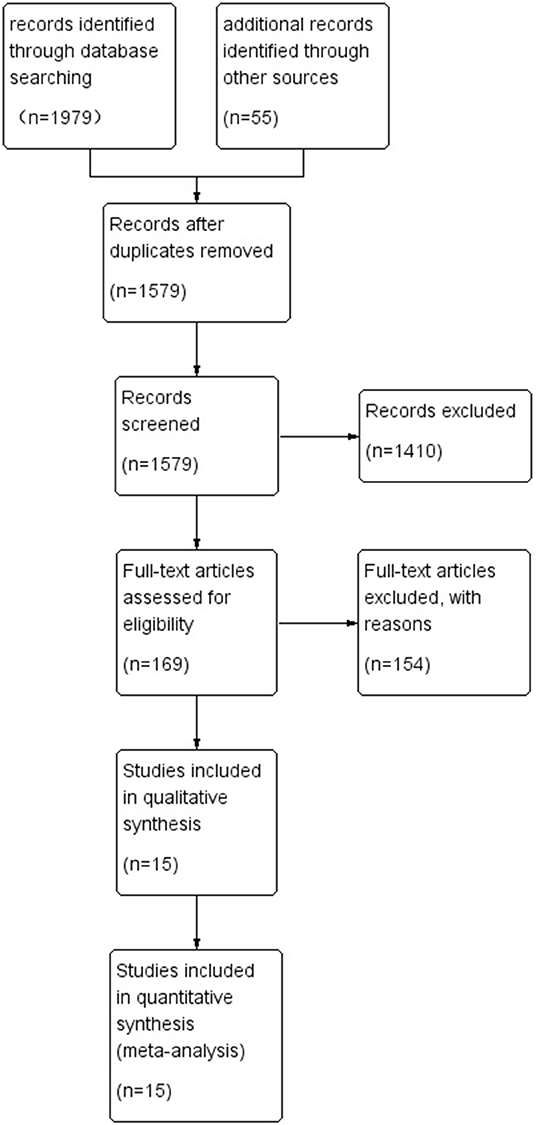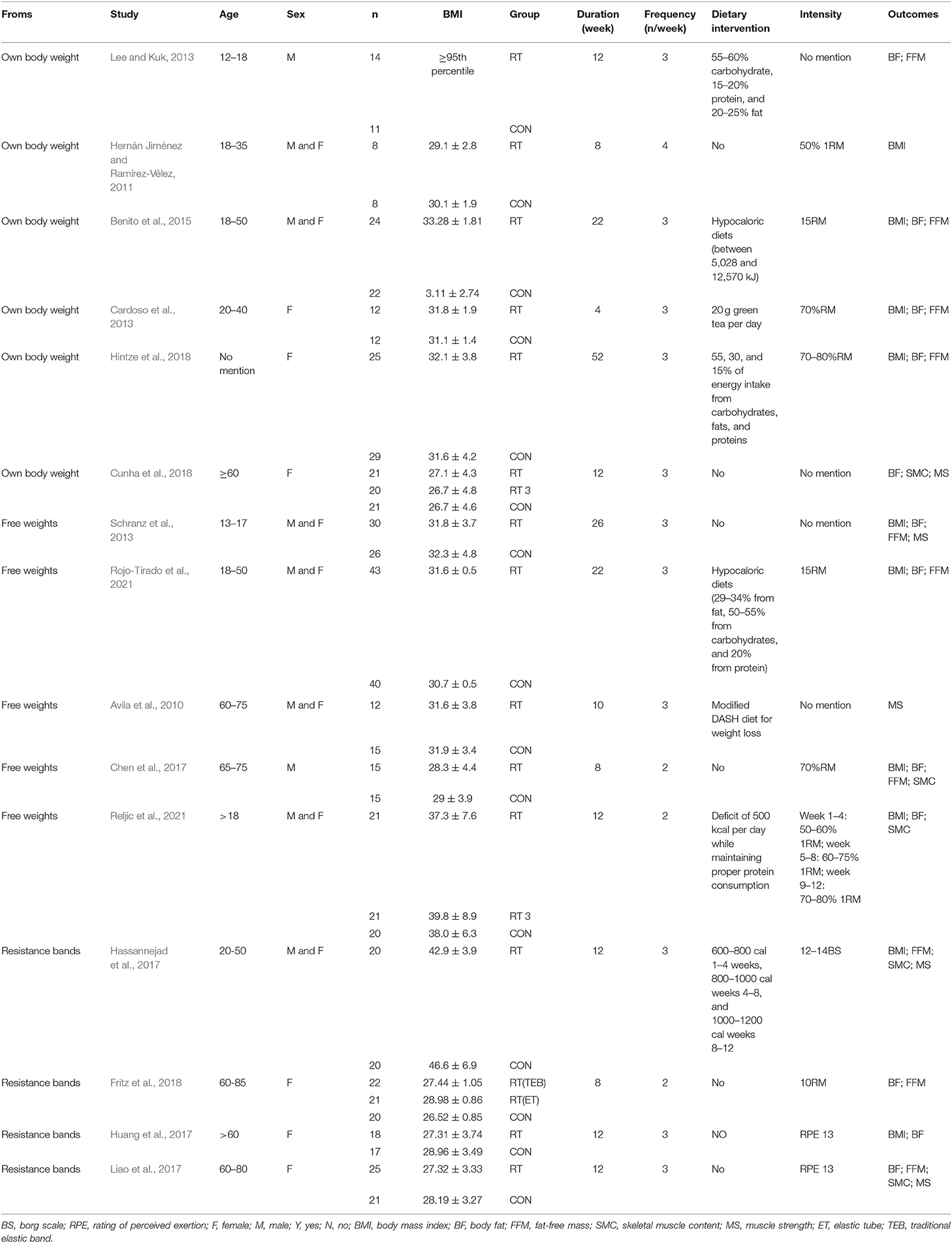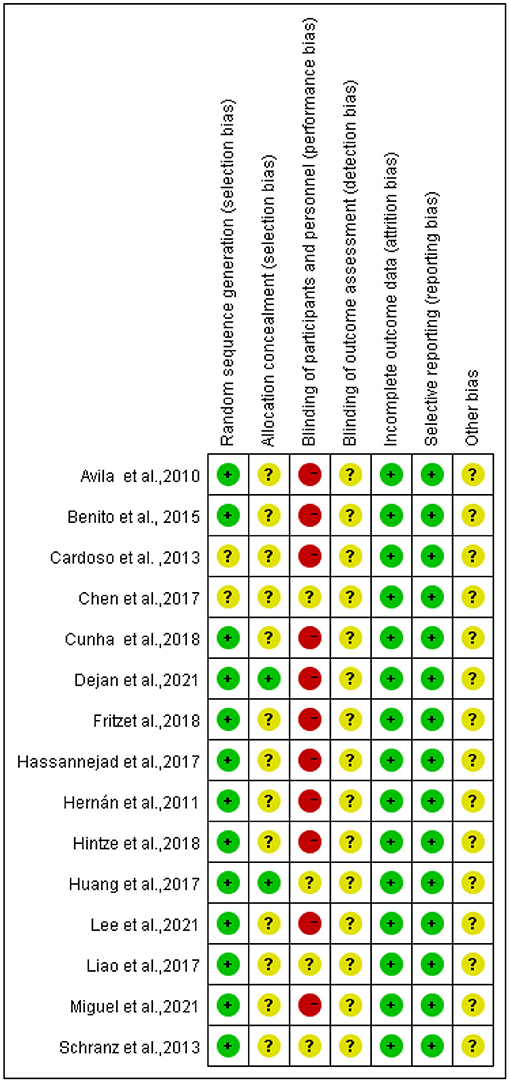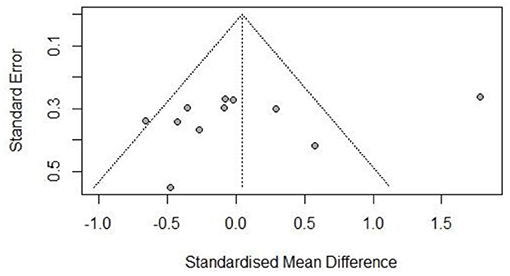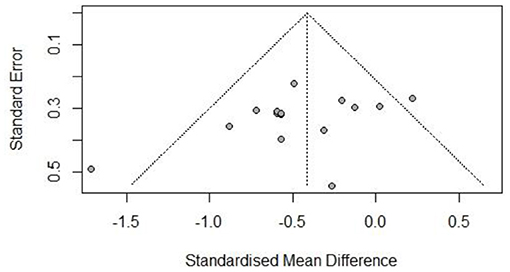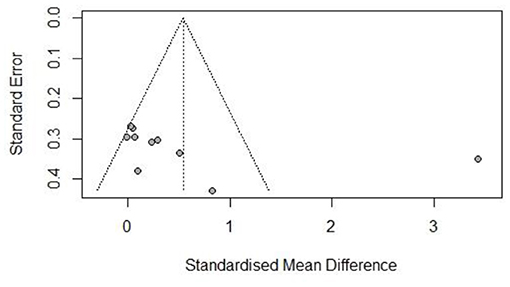- 1The School of Sports Science, Beijing Sport University, Beijing, China
- 2School of Physical Education, Northeast Normal University, Jilin, China
Purpose: This study is a systematic review and meta-analysis to determine the effects of different forms of resistance training on body composition and muscle strength in overweight and/or obese people.
Method: Only randomized controlled trials (RCTs) were included by searching relevant databases such as a web of science, PubMed, and EBSCO, with search dates up to September 30, 2021. These trials performed resistance exercise training in overweight and/or obese people, and outcome indicators included evaluation of body composition and muscle strength, among other relevant indicators. The Cochrane evaluation tool was used to evaluate the methodological quality of the included literature, and statistical analysis was performed using the R analysis software.
Results: Fifteen studies, 18 trials, with a total of 669 participants meeting eligibility criteria were included in the final analysis, which included three resistance training types (own body weight, resistance bands, and free weight). The results showed that resistance bands improved body fat (BF; SMD −0.79, 95% CI −1.25 to −0.33, I2 = 0%) in overweight or obese people better than other resistance training types. Own body weight resistance training was better for increasing skeletal muscle mass in overweight or obese people (SMD 0.48, 95% CI 0.04–0.92, I2 = 0%). In addition, for muscle strength increase, although resistance exercise was shown to improve muscle strength, there was no significant difference between the three exercise forms compared.
Conclusion: Resistance bands can improve body composition by reducing BF. Resistance bands can improve body composition by reducing BF, while it is more effective in increasing muscle mass and own body weight. Therefore, for overweight and obese people, resistance bands resistance exercise can be taken for fat loss, and resistance exercise for own body weight for further muscle gain and maintenance of muscle mass, so as to achieve the purpose of improving body composition.
Introduction
Nowadays, obesity has become one of the most important factors that endanger people's health. Especially in Europe and the United States (Flegal et al., 2016), nearly one-third of the population is diagnosed as overweight or obese (Olds et al., 2010). Obesity can lead to a range of health problems, including the induction of cardiovascular diseases (Barrett-Connor, 1985; Aslibekyan and Garvey, 2017), insulin resistance (Cortés et al., 2020), and psychological disorders (Erermis et al., 2004). The most direct of these is that it causes a decrease in skeletal muscle contractile function (Bollinger, 2017; Tallis et al., 2018), which leads to a decrease in skeletal muscle strength. Relevant studies have also shown that the relative muscle strength of overweight and obese people is significantly lower than that of healthy people (Bollinger, 2017), which can lead to decreased physical function and even the occurrence of lifelong disability (Choi et al., 2016; Eshima et al., 2017). Therefore, improving body composition and increasing muscle strength in overweight and obese populations has become an urgent issue to be addressed.
Usually, overweight and/or obese people adopt aerobic exercise to reduce fat mass and, thus, improve body composition. However, often aerobic exercise reduces fat mass with a significant decrease in muscle mass and muscle strength (Villareal et al., 2017). Resistance training, as a representative of anaerobic training, can increase muscle strength by improving muscle performance and, thus, muscle strength. Moreover, the resistance exercise not only leads to a decrease in fat mass but also increases lean body mass, thus potentially making a person stronger in absolute terms (Shaibi et al., 2006; McGuigan et al., 2009). However, the effects of different resistance training forms may differ, and their effects on muscle strength and muscle mass are unclear. Additionally, the improvement of body composition by resistance training is still unknown. Therefore, it is particularly important to explore the improvements in body composition and muscle strength with different resistance exercise forms.
Although several meta-analyses have summarized the effects of resistance training on muscle gain and fat loss (Orange et al., 2020), the studies have not specifically investigated which resistance exercise forms are more effective in improving body composition and muscle strength, especially in overweight and obese people. Therefore, the purpose of this meta-analysis was to systematically review and meta-analyze the effects of different forms of resistance training on body composition and muscle strength in overweight and/or obese populations. Additionally, to investigate suitable resistance exercise forms for overweight and obese populations to inform future personalized exercise prescriptions.
Method
Search Strategy
Databases, such as Web of Science, PubMed, EBSCO, CNKI, Wanfang, and Weipu, were searched through September 30, 2021. Search terms included “resistance training,” “strength training,” “resistance exercise,” “weight training,” “overweight,” “obesity,” “Body Weight,” “strength,” “power,” and “Body Compositions.” Use the standard Boolean operators (AND, OR) to concatenate search terms, e.g., PubMed's search formula is as follows: ((resistance training [Text Word]) OR (strength training [Text Word])OR (resistance exercise [Text Word])OR (weight training [Text Word])) AND ((overweight [Text Word]) OR (obesity [Text Word]) OR (Body Weight [Text Word])) AND ((strength [Text Word]) OR (power [Text Word]) OR (Body Compositions [Text Word])), and track references for inclusion in the literature and related reviews.
Inclusion Criteria
Inclusion criteria followed the PICOS principles (i.e., population, intervention, comparison, outcome, and study design): (1) all populations included in this study were overweight and/or obese; (2) the intervention needed to include at least 4 weeks of exercise intervention and had to be resistance training; (3) the control group remained in the same condition as the study group, but without the exercise intervention; (4) outcomes needed to include: body mass index (BMI), body fat (BF), fat-free mass (FFM), skeletal muscle content (SMC), and muscle strength (MS); (5) the type of study was a randomized controlled trial (RCT); and (6) the mean and SD were reported in the trial.
Exclusion Criteria
Trials that met the following exclusion criteria were excluded: (1) meeting abstracts, case reports, reviews, overviews, and experimental animal studies; (2) the results did not meet the inclusion criteria; (3) study type was not an RCT; and (4) mean and SD could not be obtained from the article or authors.
Studies Selection
Two reviewers (XL and JL) independently reviewed the titles or abstracts of all studies. A thorough and careful review of relevant studies was conducted to assess whether they could be included in the studies reviewed. Any disagreements were resolved by discussion or consultation with 89 a third author (YG) if necessary.
Quality Assessment
The Cochrane Collaboration tool was used to assess the risk of bias in the included trials. Two reviewers (QR and YJ) independently assessed the following seven areas of bias: random sequence generation (selection bias), allocation concealment (selection bias), blinding of participants and personnel (performance bias), blinding of outcome assessment (detection bias), incomplete outcome data (attrition bias), and selective reporting (reporting bias). Three levels of high, low, or unclear bias were indicated for each study. Disagreements were resolved by discussion or consultation with a third independent reviewer (XS), if necessary.
Data Extraction
Two reviewers independently extracted the following data from each included eligible trial: study characteristics (i.e., author and year), participant characteristics (i.e., age and number of participants), and description and outcome of the intervention. Any disagreements were resolved through discussion to reach an agreement, and the authors of the trials were contacted directly to obtain the original studies and data when necessary.
Statistical Analysis
All statistical analyses were performed using R (RStudio V4.19, Boston, MA, USA) and meta-packages. The percentage change between studies indicating heterogeneity was reported using the I2 statistic and the chi-square test. Interpretation of the I2 statistic was by the Cochrane guidelines as follows: low heterogeneity is assumed when I2 <25%, moderate heterogeneity is assumed when I2 <75% and >25%, and high heterogeneity is assumed when I2 > 75% (Higgins et al., 2003). Evidence of heterogeneity is indicated by statistically significant effects based on the chi-square test. If p < 0.05, it is considered as a significant difference. Sensitivity analysis was used to investigate the sources of heterogeneity and to assess the stability of the results by removing each test individually. All experimental data were continuous variables. The value of the quantitative data was expressed by the mean difference (MD) and 95% CI. If more than 9 trials were included, possible publication bias was assessed by the funnel plot asymmetry and Egger's test.
Results
Search Results
A total of 1,979 studies were retrieved in the database according to the search strategy, and an additional 55 studies were included through other sources (e.g., personal communication with academic peers and searching reference lists). A total of 455 duplicates were removed from the Endnote literature management software, 1,410 studies were excluded after reading the titles and abstracts, 154 studies were excluded after reading the full text and eligibility assessment, and 15 studies were finally included (Avila et al., 2010; Hernán Jiménez and Ramírez-Vélez, 2011; Cardoso et al., 2013; Lee and Kuk, 2013; Schranz et al., 2014; Benito et al., 2015; Chen et al., 2017; Hassannejad et al., 2017; Huang et al., 2017; Liao et al., 2017; Cunha et al., 2018; Fritz et al., 2018; Hintze et al., 2018; Reljic et al., 2021; Rojo-Tirado et al., 2021), and the literature screening process is shown in Figure 1.
Description of Included Studies
The characteristics of the included studies are described in Table 1, including first author name, year of publication, age, sex, sample size, intervention methods, and outcomes. A total of 15 of the included studies were published in 2010 and later, and a total of 669 subjects were included who met the BMI values for overweight and obesity in the country. Six of the studies had resistance forms as own body weight, five studies had free weight, and four studies had resistance bands.
Risk of Bias of Included Studies
The risk of bias was assessed for each included study based on Higgins and Green's study (Figure 2). A total of 15 articles were included in this study, all of which used randomization methods, with six articles mentioning the specific method of random assignment. Some articles did not report any information about allocation concealment. None of the trials met the requirement of participant blinding. However, the use of blinding did not appear to be feasible considering the exercise intervention. All articles presented full outcome indicators and stated the likelihood of reviewing the results and outcomes. All studies were unsure of the presence of other biases. Figures 3–5 show funnel plots for BMI, BF, and FFM, showing the MD of each study with its precision (SE). Visual inspection of the funnel plots revealed no significant asymmetries. Statistical tests for publication bias using the Egger regression did not reach statistical significance (Egger test for BMI, p = 0.28; Egger test for BF, p = 0.09; Egger test for FFM, p = 0.21).
Effect of Intervention
Body Composition
Body composition was assessed by the following four main indicators (BMI, BF, FFM, and SMC). A total of 11 data points report the change in BMI by resistance exercise (Figure 6). Random-effects models showed no statistically significant differences in BMI in the obese or/and overweight population compared to controls before and after the resistance exercise intervention (I2 = 82%, p = 0.84). After analyzing the different resistance types by the subgroup analysis, resistance bands well improved the BMI values of overweight and obese people (SMD −0.54, 95% CI −1.01 to −0.07, I2 = 0%), although there was no significant difference between groups.
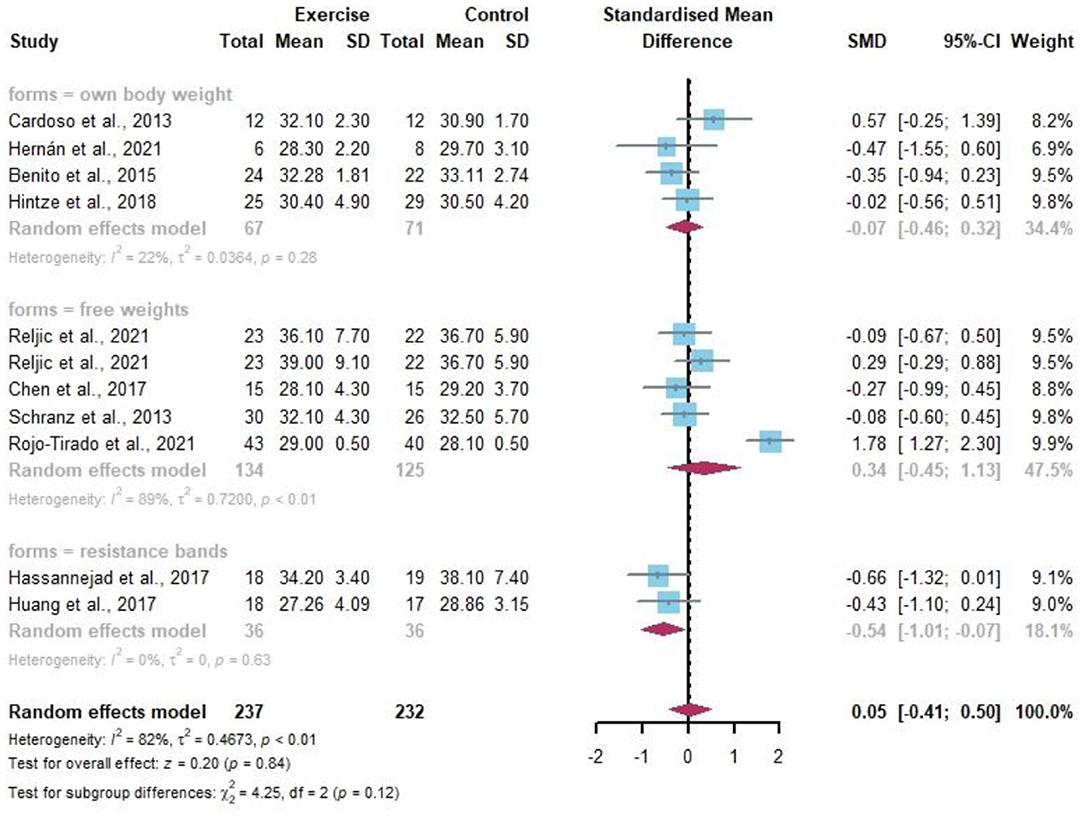
Figure 6. Meta-analysis of effects of different resistance exercise forms on body mass index (BMI) of overweight and/or obese individuals.
Sixteen data points reported changes in resistance exercise on BF (Figure 7). Random-effects models showed statistically significant differences in BF in the obese or/and overweight population before and after the resistance exercise intervention compared to the control group (I2 = 63%, p < 0.01). After analyzing the different resistance types by the subgroup analysis, resistance bands well improved the percentage of BF in the overweight and obese population (SMD −0.68, 95% CI −1.00 to −0.37, I2 = 0%).
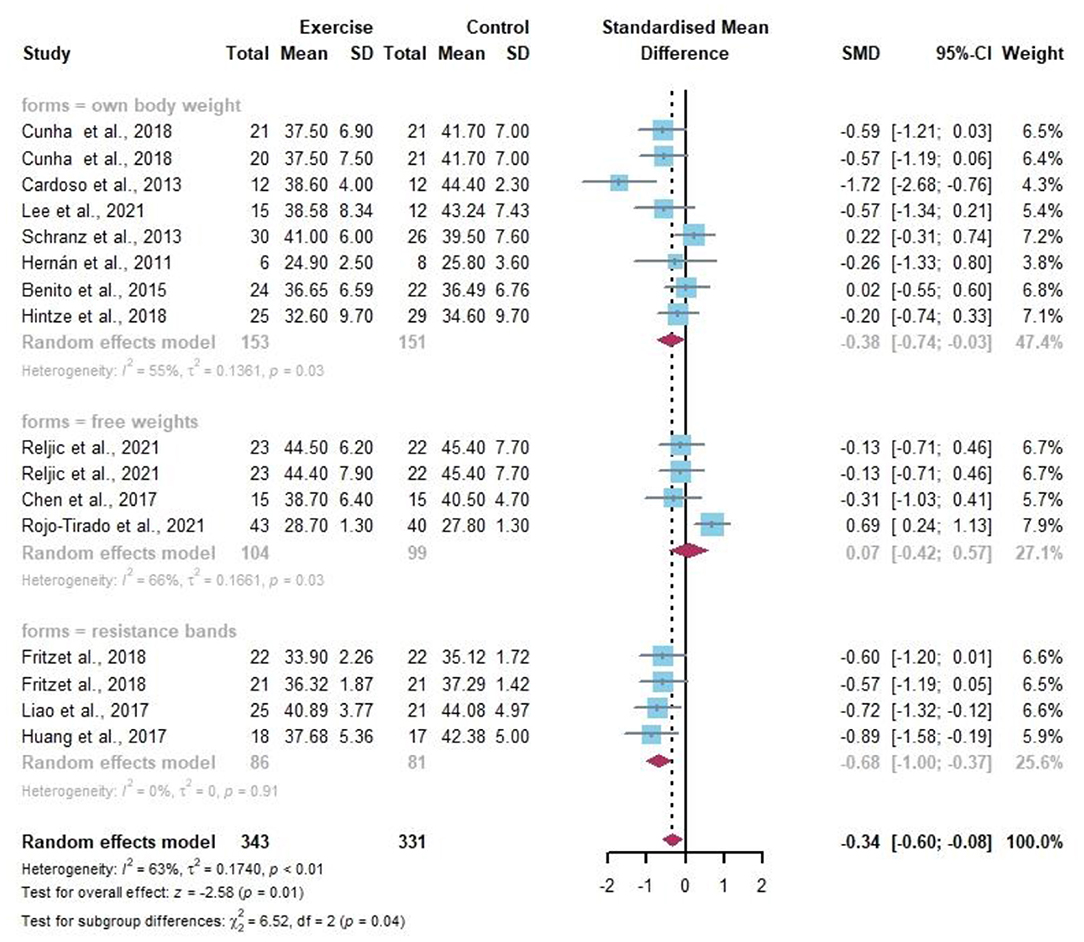
Figure 7. Meta-analysis of effects of different resistance exercise forms on body fat (BF) of overweight and/or obese individuals.
Ten data points reported changes in resistance exercise for FFM (Figure 8). Random-effects models showed no statistically significant differences in BMI in obese or/and overweight individuals before and after the resistance exercise intervention compared to controls (I2 = 89%, p = 0.06). After analysis of the different resistance types by the subgroup analysis, none of them were significantly different.
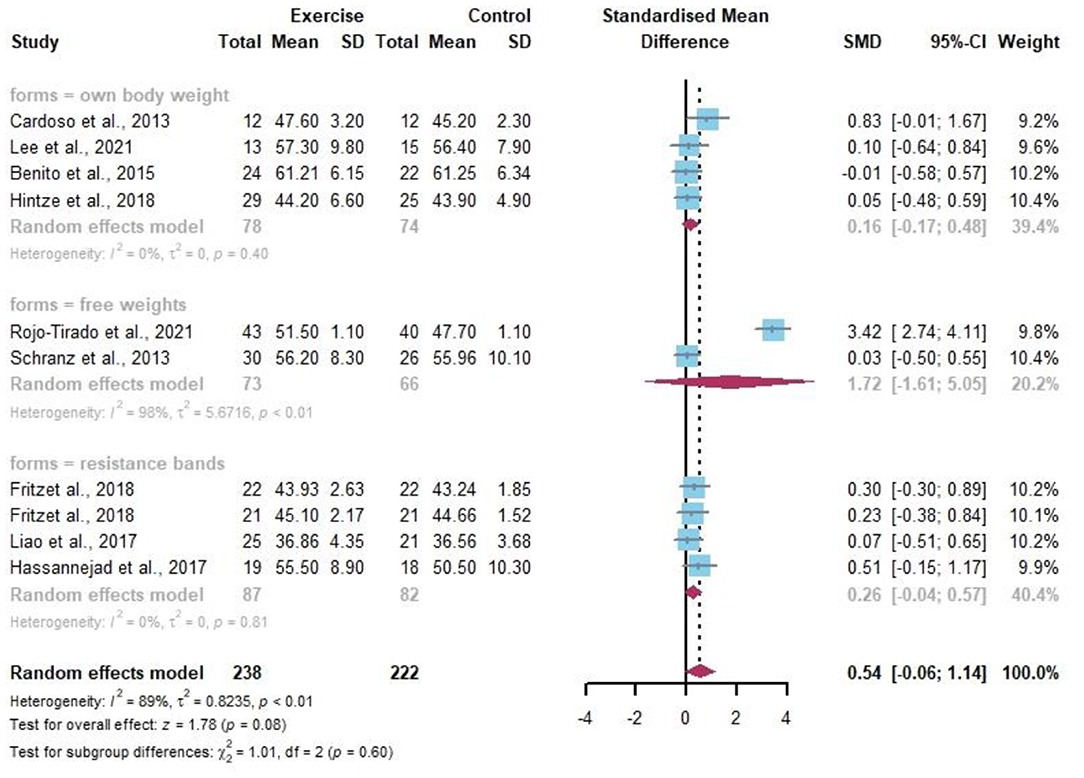
Figure 8. Meta-analysis of effects of different resistance exercise forms on FFM of overweight and/or obese individuals.
Seven data points reported the change in SMC by resistance exercise (Figure 9). Random-effects models showed differences and statistical significance in SMC in obese or/and overweight individuals compared to controls before and after the resistance exercise intervention (I2 = 0%, p = 0.03). The percentage of SMC in overweight and/or obese individuals was well improved by the subgroup analysis after different forms of resistance by own body weight (SMD 0.48, 95% CI 0.04–0.92, I2 = 0%).
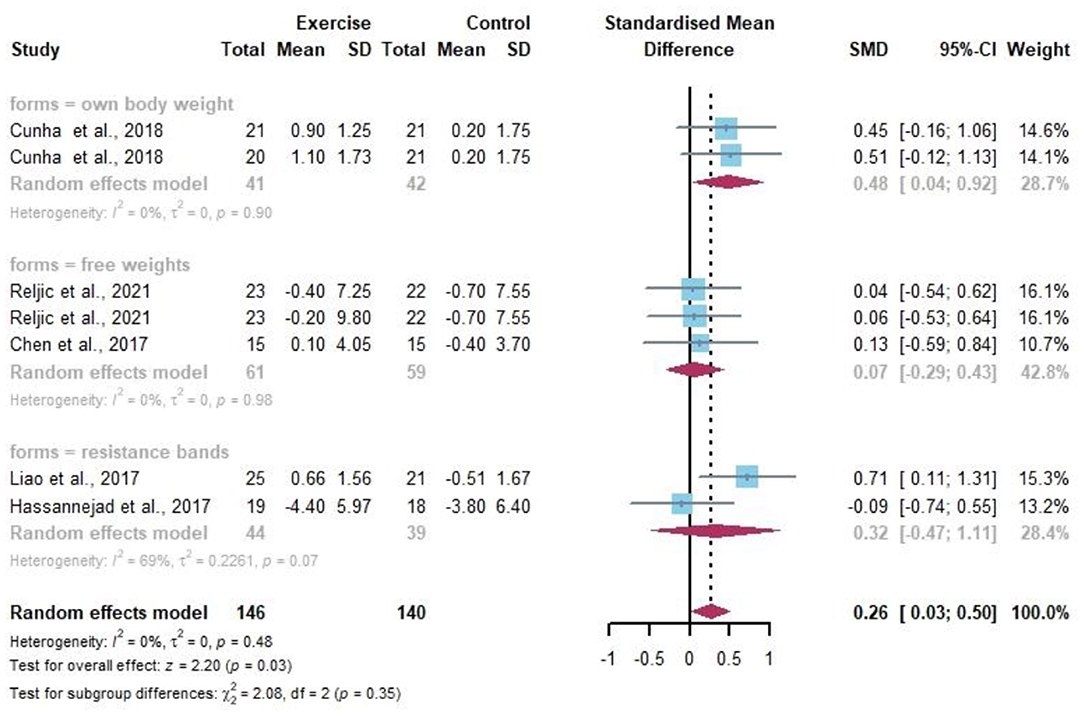
Figure 9. Meta-analysis of effects of different resistance exercise forms on SMC of overweight and/or obese individuals.
Muscle Strength
Eight data points reported the change in resistance exercise on MS (Figure 10). The random-effects model showed a statistically significant difference in MS in the obese or/and overweight population before and after the resistance exercise intervention compared to the control group (I2 = 91%, p < 0.01). Sensitivity analysis showed that the effect of either article exclusion on the overall heterogeneity was not significant, indicating more stable results with high confidence. Although all three modalities were effective in increasing muscle strength, no significant differences were found between groups by the subgroup analysis.
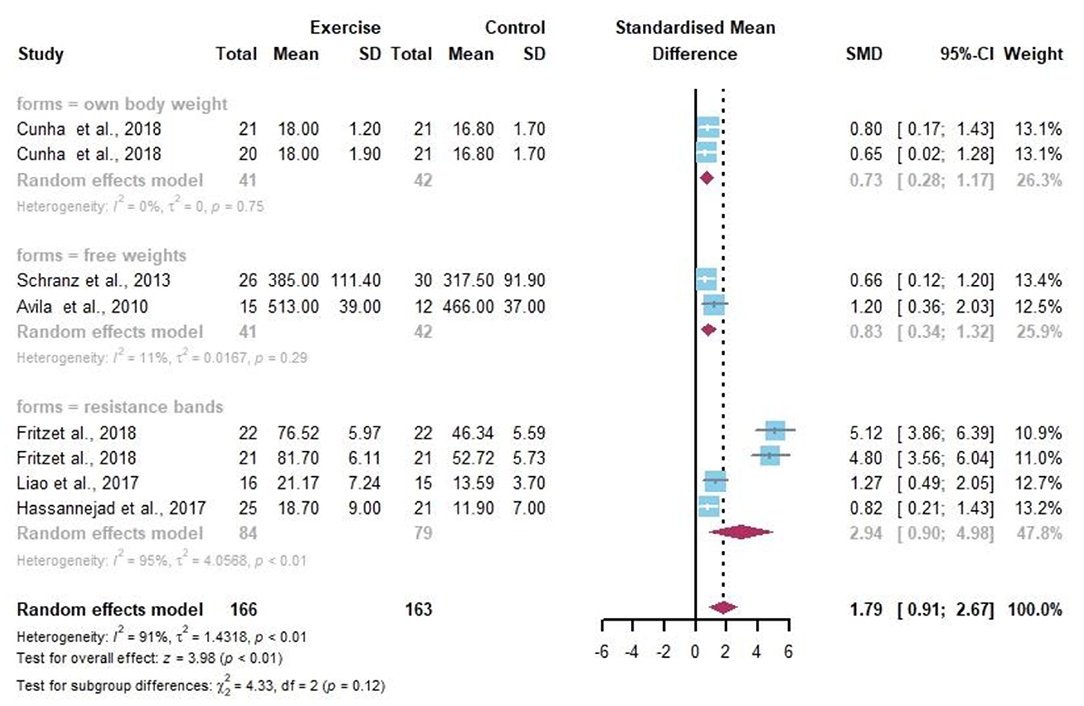
Figure 10. Meta-analysis of effects of different resistance exercise forms on MS of overweight and/or obese individuals.
Discussion
This review pooled RCTs, 15 studies, and 18 trials with a total of 669 participants in a meta-analysis to assess the effects of different forms of resistance exercise on improving body composition and strength in overweight and/or obese people. By comparing different forms of resistance exercise, we found that resistance bands have the best effect on fat loss for overweight and obese people and a better effect on muscle gain for their own body weight. In addition, own body weight had the best effect on increasing muscle strength in overweight and/or obese people.
Body Composition
Body composition is related to various physiological and pathological states, and the determination of body composition usually includes multiple indicators (Müller et al., 2012), and the evaluation of obesity should not be determined by BMI values alone but should include BF, FFM, and SMC (Bosy-Westphal and Müller, 2021), thus, its more accurate and comprehensive evaluation of its body composition. This review showed that the effect of resistance training on their BMI values and FFM was not significant, which is generally consistent with previous studies (Schranz et al., 2013). We found by the subgroup analysis of resistance exercise with different forms that own body weight and free weights did not significantly improve BMI values, BF percentage, and FFM, and free weights and resistance bands did not significantly improve SMC.
In contrast to previous studies, we found that resistance bands significantly improved BMI, although there was no significant difference between groups, and for overweight and obese people, resistance bands significantly reduced BF in overweight and obese people, and resistance bands can significantly reduce the BF value to achieve fat loss. This may be due to the special structure of resistance bands; the tensile force will gradually increase with its elongation, so the intensity of resistance training is not high, and the body mainly uses the aerobic oxidation of sugar and fat for energy supply, which can be very high to achieve the purpose of fat loss (Astorino, 2000; Stisen et al., 2006). And compared with other forms of resistance exercise, resistance bands can change the direction of resistance at will, the user can basically train most of the muscles of the body in any position and posture, so it can be very good to achieve the purpose of fat burning. But because of its resistance training intensity is not high, can not cause further stimulation of the muscle, so the effect of resistance bands on muscle gain is not ideal.
Furthermore, own body weight, as the only form of resistance exercise, can significantly increase muscle mass. For overweight and obese people, they are heavier, so the intensity of resistance bands is sufficient to stimulate the muscles and promote the thickening of muscle fibers. In addition, self-weight training can simultaneously allow our muscles to participate in the movement; rather than isolated muscle stimulation, this training is more comprehensive to increase all muscle groups, thus achieving the purpose of muscle building.
This is a very exciting finding, as it has been previously reported that obesity reduces the effect of resistance exercise on improving body composition. For example, a 6-month period of resistance exercise showed that resistance exercise was good for increasing strength but not statistically significant for improving body composition (Schranz et al., 2014). In a subsequent study, it was also found that resistance exercise for 1 year did not improve body mass in obese people (Hintze et al., 2018). So, the findings of this study certainly break with the traditional aerobic exercise that has been the main means of weight loss (Fogelholm et al., 2000; Villanova et al., 2006), especially for the overweight and obese population. After all, compared to aerobic exercise, resistance exercise can increase lean body mass and muscle mass in addition to reducing fat content (García-Hermoso et al., 2018), thus better-improving body composition. Therefore, this finding undoubtedly provides strong support for resistance training as an effective way to combat obesity, lose fat, and gain muscle.
Since caloric restriction can improve body composition by accelerated loss of fat mass and blunted increase in FFM, it has been considered effective for weight loss in overweight and obese populations in previous studies (Astrup et al., 2004). In this study, we performed the subgroup analysis with and without dietary intervention to better assess the effect of different forms of resistance exercise on body composition in overweight and obese people −1.16 to −0.07, p = 0.08), and FFM (SMD 0.94, 95% CI −0.33 to 2.21, p = 0.65) were not significantly improved. This reinforces the reference value of the differences in the effects of different forms of resistance exercise on body composition in overweight and obese people.
Muscle Strength
Muscle strength is one of the indicators that respond to a person's functional capacity (Barbat-Artigas et al., 2014). Lower muscle strength leads to reduced physical mobility and increased risk of falls and fractures, especially in the aging population (Visser et al., 2005; Newman et al., 2006). The muscle strengths incorporated in this study are all absolute strengths, which are particularly important for grasping the intensity of exercise and reducing the occurrence of sports injuries. There should be no doubt that resistance exercise increases muscle mass (Peterson and Gordon, 2011; Candow et al., 2012) and muscle strength (Peterson et al., 2010; Larsson et al., 2015), and this is equally supported by the literature on obese and overweight population (Avila et al., 2010; Cunha et al., 2018). Current studies have mainly shown that resistance exercise increases muscle mass and strength by increasing the expression of relevant skeletal muscle synthesis proteins and decreasing catabolic levels (Dreyer et al., 2010; Peterson et al., 2010; Agergaard et al., 2017).
In this study, by comparing the three forms of resistance exercises, it was found that there was no significant difference between the three exercise forms for strength improvement, but the resistance bands showed a better trend for muscle strength improvement compared to the other two forms, and the subgroup analysis showed low heterogeneity, which can also better indicate that the data are more stable and reliable. The reliability of the data was high. Due to the specific structure of resistance bands, the tensile force increases gradually with their elongation, leading to changes in the muscle itself (muscle fiber type, muscle structure, myofilament density, structure of connective tissue, and tendons) and an increase in muscle nerve adaptation. In particular, the results of this article show that the magnitude of the effect of resistance exercise on MS appears to be greater than that on SMC in overweight or obese people, implying that the effect of resistance exercise on muscle neural recruitment and/or muscle contractile function is greater than the effect on “fiber thickening.” Therefore, for overweight and obese people, there may be a decrease in muscle anabolism, and the mechanism for increasing muscle strength is likely to be mainly resistance exercise that increases muscle neural recruitment and/or muscle contractile function. Compared to own body weight and free weights, the intensity of resistance training can be customized and optimized, and it is more functional, usually with the coordination of multiple muscle groups, so it is more effective in increasing muscle strength. Additionally, because overweight and obese people are heavier, the pressure on the joints is greater than that of healthy people, so resistance training with free weights and own body weight will undoubtedly increase the pressure on the joints, which will easily cause damage to the joints and is not suitable for overweight and obese people. In addition, resistance bands, unlike other resistance training forms, are not controlled by the training site and are very light to practice, so they will greatly benefit the health of all people.
Strength and Limitations
This review is the first to examine the effects of different forms of resistance exercise on body composition and muscle strength in overweight and/or obese populations with outcome measures including BMI, BF, FFM, SMC, and MS. In addition, the evidence from RCTs will be more rigorous and objective than that from case studies. Compared to previous studies, this study includes different forms of resistance training to evaluate which resistance training forms can better improve body composition and strength, thus making training more precise and a significant contribution to personalized exercise prescription. Additionally, this review is a meta-analysis, which improves the statistical power of the article, provides more precise data, and addresses the reasons for conflicting results between different experimental studies.
Although the studies included in this review may not be typical of resistance exercise to assess changes in body composition and strength in different forms in obese populations, they provide a benchmark. It is suggested that the effects of resistance exercise on body composition and strength are beneficial and that different forms of resistance exercise can be used to achieve different effects (fat loss, muscle gain, strength gain, etc.), especially in overweight and obese populations. In terms of overweight and obese people, choosing resistance bands for fat loss and resistance exercise for their own body weight to increase muscle mass and increase muscle strength would be the best choice. Although the subgroup analysis of the factors that may influence the results of this study (caloric restriction, exercise volume, etc.) did not significantly interfere with the results of the experiment, however, due to the small number of studies available, especially for the subgroup analysis, the included literature is more limited and single, which may be limiting. In addition, the age of the subjects in their own body weight was ≥12, the age of the subjects in the free weights was ≥13, and the age of the subjects in the resistance bands was ≥20. The subjects in the resistance bands were indeed slightly older, but overall, the age range of the subjects included in all three training modalities was wide. Due to the limitations of the included literature, the variable of age was not taken into account in this paper; therefore, future studies on different resistance exercise forms should be increased, especially for overweight and obese people for different age groups, and studies combining dietary interventions and resistance training should be increased in order to better inform future personalized exercise prescriptions.
Conclusion
This systematic review and meta-analysis show that different forms of resistance exercise have different effects on overweight and obese individuals. Resistance bands can improve body composition by decreasing BF. Resistance bands can improve body composition by decreasing BF but are more effective at increasing muscle mass and own body weight. Therefore, for overweight and obese people, resistance bands can be used to lose fat, while resistance weights can be used to gain muscle and maintain muscle mass, thus improving body composition. However, given the limitations outlined in this study, it is necessary to take the results with a grain of salt. More RCTs with large sample sizes are needed to better understand the effectiveness of different forms of resistance exercise interventions on body composition and muscle strength.
Data Availability Statement
The original contributions presented in the study are included in the article/supplementary material, further inquiries can be directed to the corresponding author/s.
Author Contributions
XL and XS designed the systematic review. JLu and YG analyzed the data. QM prepared the figures and table. XL wrote the manuscript. YS and JLi revised the manuscript. All authors reviewed and approved the manuscript.
Funding
This study was supported by the National Key Research and Development Program of China (Grant No. 2018YFC2000600) and the Fok Ying Tung Education Foundation (No. 161094).
Conflict of Interest
The authors declare that the research was conducted in the absence of any commercial or financial relationships that could be construed as a potential conflict of interest.
Publisher's Note
All claims expressed in this article are solely those of the authors and do not necessarily represent those of their affiliated organizations, or those of the publisher, the editors and the reviewers. Any product that may be evaluated in this article, or claim that may be made by its manufacturer, is not guaranteed or endorsed by the publisher.
References
Agergaard, J., Bülow, J., Jensen, J. K., Reitelseder, S., Drummond, M. J., Schjerling, P., et al. (2017). Light-load resistance exercise increases muscle protein synthesis and hypertrophy signaling in elderly men. Am. J. Physiol. Endocrinol. Metab. 312, E326–e338. doi: 10.1152/ajpendo.00164.2016
Aslibekyan, S., and Garvey, W. T. (2017). Obesity: obesity and cardiometabolic disease—more than meets the eye. Nat. Rev. Endocrinol. 13, 566–568. doi: 10.1038/nrendo.2017.112
Astorino, T. A. (2000). Is the ventilatory threshold coincident with maximal fat oxidation during submaximal exercise in women? J. Sports Med. Phys. Fitness 40, 209–216. doi: 10.1067/mse.2000.107088
Astrup, A., Meinert Larsen, T., and Harper, A. (2004). Atkins and other low-carbohydrate diets: hoax or an effective tool for weight loss? Lancet 364, 897–899. doi: 10.1016/s0140-6736(04)16986-9
Avila, J. J., Gutierres, J. A., Sheehy, M. E., Lofgren, I. E., and Delmonico, M. J. (2010). Effect of moderate intensity resistance training during weight loss on body composition and physical performance in overweight older adults. Eur. J. Appl. Physiol. 109, 517–525. doi: 10.1007/s00421-010-1387-9
Barbat-Artigas, S., Pion, C. H., Leduc-Gaudet, J. P., Rolland, Y., and Aubertin-Leheudre, M. (2014). Exploring the role of muscle mass, obesity, and age in the relationship between muscle quality and physical function. J. Am. Med. Dir. Assoc. 15, 303.e313–320. doi: 10.1016/j.jamda.2013.12.008
Barrett-Connor, E. L. (1985). Obesity, atherosclerosis, and coronary artery disease. Ann. Intern. Med. 103, 1010–1019. doi: 10.7326/0003-4819-103-6-1010
Benito, P. J., Bermejo, L. M., Peinado, A. B., López-Plaza, B., Cupeiro, R., Szendrei, B., et al. (2015). Change in weight and body composition in obese subjects following a hypocaloric diet plus different training programs or physical activity recommendations. J. Appl. Physiol. 118, 1006–1013. doi: 10.1152/japplphysiol.00928.2014
Bollinger, L. M. (2017). Potential contributions of skeletal muscle contractile dysfunction to altered biomechanics in obesity. Gait Posture 56, 100–107. doi: 10.1016/j.gaitpost.2017.05.003
Bosy-Westphal, A., and Müller, M. J. (2021). Diagnosis of obesity based on body composition-associated health risks-time for a change in paradigm. Obes. Rev. 22(Suppl 2):e13190. doi: 10.1111/obr.13190
Candow, D. G., Forbes, S. C., Little, J. P., Cornish, S. M., Pinkoski, C., and Chilibeck, P. D. (2012). Effect of nutritional interventions and resistance exercise on aging muscle mass and strength. Biogerontology 13, 345–358. doi: 10.1007/s10522-012-9385-4
Cardoso, G. A., Salgado, J. M., Cesar, M. d. C, and Donado-Pestana, C. M. (2013). The effects of green tea consumption and resistance training on body composition and resting metabolic rate in overweight or obese women. J. Med. Food 16, 120–127. doi: 10.1089/jmf.2012.0062
Chen, H.-T., Chung, Y.-C., Chen, Y.-J., Ho, S.-Y., and Wu, H.-J. (2017). Effects of different types of exercise on body composition, muscle strength, and IGF-1 in the elderly with sarcopenic obesity. J. Am. Geriatr. Soc. 65, 827–832. doi: 10.1111/jgs.14722
Choi, S. J., Files, D. C., Zhang, T., Wang, Z. M., Messi, M. L., Gregory, H., et al. (2016). Intramyocellular lipid and impaired myofiber contraction in normal weight and obese older adults. J. Gerontol. A Biol. Sci. Med. Sci. 71, 557–564. doi: 10.1093/gerona/glv169
Cortés, V. A., Barrera, F., and Nervi, F. (2020). Pathophysiological connections between gallstone disease, insulin resistance, and obesity. Obes. Rev. 21:e12983. doi: 10.1111/obr.12983
Cunha, P. M., Ribeiro, A. S., Tomeleri, C. M., Schoenfeld, B. J., Silva, A. M., Souza, M. F., et al. (2018). The effects of resistance training volume on osteosarcopenic obesity in older women. J. Sports Sci. 36, 1564–1571. doi: 10.1080/02640414.2017.1403413
Dreyer, H. C., Fujita, S., Glynn, E. L., Drummond, M. J., Volpi, E., and Rasmussen, B. B. (2010). Resistance exercise increases leg muscle protein synthesis and mTOR signalling independent of sex. Acta Physiol. 199, 71–81. doi: 10.1111/j.1748-1716.2010.02074.x
Erermis, S., Cetin, N., Tamar, M., Bukusoglu, N., Akdeniz, F., and Goksen, D. (2004). Is obesity a risk factor for psychopathology among adolescents? Pediatr. Int. 46, 296–301. doi: 10.1111/j.1442-200x.2004.01882.x
Eshima, H., Tamura, Y., Kakehi, S., Kurebayashi, N., Murayama, T., Nakamura, K., et al. (2017). Long-term, but not short-term high-fat diet induces fiber composition changes and impaired contractile force in mouse fast-twitch skeletal muscle. Physiol. Rep. 5:13250. doi: 10.14814/phy2.13250
Flegal, K. M., Kruszon-Moran, D., Carroll, M. D., Fryar, C. D., and Ogden, C. L. (2016). Trends in obesity among adults in the United States, 2005 to 2014. JAMA 315, 2284–2291. doi: 10.1001/jama.2016.6458
Fogelholm, M., Kukkonen-Harjula, K., Nenonen, A., and Pasanen, M. (2000). Effects of walking training on weight maintenance after a very-low-energy diet in premenopausal obese women: a randomized controlled trial. Arch. Intern. Med. 160, 2177–2184. doi: 10.1001/archinte.160.14.2177
Fritz, N. B., Juesas, A., Gargallo, P., Calatayud, J., Fernandez-Garrido, J., Rogers, M. E., et al. (2018). Positive effects of a short-term intense elastic resistance training program on body composition and physical functioning in overweight older women. Biol. Res. Nurs. 20, 321–334. doi: 10.1177/1099800418757676
García-Hermoso, A., Ramírez-Vélez, R., Ramírez-Campillo, R., Peterson, M. D., and Martínez-Vizcaíno, V. (2018). Concurrent aerobic plus resistance exercise versus aerobic exercise alone to improve health outcomes in paediatric obesity: a systematic review and meta-analysis. Br. J. Sports Med. 52, 161–166. doi: 10.1136/bjsports-2016-096605
Hassannejad, A., Khalaj, A., Mansournia, M. A., Rajabian Tabesh, M., and Alizadeh, Z. (2017). The effect of aerobic or aerobic-strength exercise on body composition and functional capacity in patients with BMI ≥35 after bariatric surgery: a randomized control trial. Obes. Surg. 27, 2792–2801. doi: 10.1007/s11695-017-2717-3
Hernán Jiménez, O., and Ramírez-Vélez, R. (2011). [Strength training improves insulin sensitivity and plasma lipid levels without altering body composition in overweight and obese subjects]. Endocrinol. Nutr. 58, 169–174. doi: 10.1016/j.endonu.2011.02.005
Higgins, J. P., Thompson, S. G., Deeks, J. J., and Altman, D. G. (2003). Measuring inconsistency in meta-analyses. BMJ 327, 557–560. doi: 10.1136/bmj.327.7414.557
Hintze, L. J., Messier, V., Lavoie, M., Brochu, M., Lavoie, J. M., Prud'homme, D., et al. (2018). A one-year resistance training program following weight loss has no significant impact on body composition and energy expenditure in postmenopausal women living with overweight and obesity. Physiol. Behav. 189, 99–106. doi: 10.1016/j.physbeh.2018.03.014
Huang, S. W., Ku, J. W., Lin, L. F., Liao, C. D., Chou, L. C., and Liou, T. H. (2017). Body composition influenced by progressive elastic band resistance exercise of sarcopenic obesity elderly women: a pilot randomized controlled trial. Eur. J. Phys. Rehabil. Med. 53, 556–563. doi: 10.23736/s1973-9087.17.04443-4
Larsson, A., Palstam, A., Löfgren, M., Ernberg, M., Bjersing, J., Bileviciute-Ljungar, I., et al. (2015). Resistance exercise improves muscle strength, health status and pain intensity in fibromyalgia—a randomized controlled trial. Arthritis Res. Ther. 17:161. doi: 10.1186/s13075-015-0679-1
Lee, S., and Kuk, J. L. (2013). Changes in fat and skeletal muscle with exercise training in obese adolescents: comparison of whole-body MRI and dual energy X-ray absorptiometry. Obesity. 21, 2063–2071. doi: 10.1002/oby.20448
Liao, C. D., Tsauo, J. Y., Lin, L. F., Huang, S. W., Ku, J. W., Chou, L. C., et al. (2017). Effects of elastic resistance exercise on body composition and physical capacity in older women with sarcopenic obesity: a CONSORT-compliant prospective randomized controlled trial. Medicine. 96:e7115. doi: 10.1097/md.0000000000007115
McGuigan, M. R., Tatasciore, M., Newton, R. U., and Pettigrew, S. (2009). Eight weeks of resistance training can significantly alter body composition in children who are overweight or obese. J. Strength Cond. Res. 23, 80–85. doi: 10.1519/jsc.0b013e3181876a56
Müller, M. J., Lagerpusch, M., Enderle, J., Schautz, B., Heller, M., and Bosy-Westphal, A. (2012). Beyond the body mass index: tracking body composition in the pathogenesis of obesity and the metabolic syndrome. Obes. Rev. 13(Suppl 2), 6–13. doi: 10.1111/j.1467-789X.2012.01033.x
Newman, A. B., Kupelian, V., Visser, M., Simonsick, E. M., Goodpaster, B. H., Kritchevsky, S. B., et al. (2006). Strength, but not muscle mass, is associated with mortality in the health, aging and body composition study cohort. J. Gerontol. A Biol. Sci. Med. Sci. 61, 72–77. doi: 10.1093/gerona/61.1.72
Olds, T. S., Tomkinson, G. R., Ferrar, K. E., and Maher, C. A. (2010). Trends in the prevalence of childhood overweight and obesity in Australia between 1985 and 2008. Int. J. Obes. 34, 57–66. doi: 10.1038/ijo.2009.211
Orange, S. T., Madden, L. A., and Vince, R. V. (2020). Resistance training leads to large improvements in strength and moderate improvements in physical function in adults who are overweight or obese: a systematic review. J. Physiother. 66, 214–224. doi: 10.1016/j.jphys.2020.09.009
Peterson, M. D., and Gordon, P. M. (2011). Resistance exercise for the aging adult: clinical implications and prescription guidelines. Am. J. Med. 124, 194–198. doi: 10.1016/j.amjmed.2010.08.020
Peterson, M. D., Rhea, M. R., Sen, A., and Gordon, P. M. (2010). Resistance exercise for muscular strength in older adults: a meta-analysis. Ageing Res. Rev. 9, 226–237. doi: 10.1016/j.arr.2010.03.004
Reljic, D., Herrmann, H. J., Neurath, M. F., and Zopf, Y. (2021). Iron beats electricity: resistance training but not whole-body electromyostimulation improves cardiometabolic health in obese metabolic syndrome patients during caloric restriction-a randomized-controlled study. Nutrients. 13:1640. doi: 10.3390/nu13051640
Rojo-Tirado, M. A., Benito, P. J., Ruiz, J. R., Ortega, F. B., Romero-Moraleda, B., Butragueno, J., et al. (2021). Body composition changes after a weight loss intervention: a 3-year follow-up study. Nutrients 13:164. doi: 10.3390/nu13010164
Schranz, N., Tomkinson, G., and Olds, T. (2013). What is the effect of resistance training on the strength, body composition and psychosocial status of overweight and obese children and adolescents? A systematic review and meta-analysis. Sports Med. 43, 893–907. doi: 10.1007/s40279-013-0062-9
Schranz, N., Tomkinson, G., Parletta, N., Petkov, J., and Olds, T. (2014). Can resistance training change the strength, body composition and self-concept of overweight and obese adolescent males? A randomised controlled trial. Br. J. Sports Med. 48, 1482–1488. doi: 10.1136/bjsports-2013-092209
Shaibi, G. Q., Cruz, M. L., Ball, G. D., Weigensberg, M. J., Salem, G. J., Crespo, N. C., et al. (2006). Effects of resistance training on insulin sensitivity in overweight Latino adolescent males. Med. Sci. Sports Exerc. 38, 1208–1215. doi: 10.1249/01.mss.0000227304.88406.0f
Stisen, A. B., Stougaard, O., Langfort, J., Helge, J. W., Sahlin, K., and Madsen, K. (2006). Maximal fat oxidation rates in endurance trained and untrained women. Eur. J. Appl. Physiol. 98, 497–506. doi: 10.1007/s00421-006-0290-x
Tallis, J., James, R. S., and Seebacher, F. (2018). The effects of obesity on skeletal muscle contractile function. J. Exp. Biol. 221:163840. doi: 10.1242/jeb.163840
Villanova, N., Pasqui, F., Burzacchini, S., Forlani, G., Manini, R., Suppini, A., et al. (2006). A physical activity program to reinforce weight maintenance following a behavior program in overweight/obese subjects. Int. J. Obes. 30, 697–703. doi: 10.1038/sj.ijo.0803185
Villareal, D. T., Aguirre, L., Gurney, A. B., Waters, D. L., Sinacore, D. R., Colombo, E., et al. (2017). Aerobic or resistance exercise, or both, in dieting obese older adults. N. Engl. J. Med. 376, 1943–1955. doi: 10.1056/NEJMoa1616338
Visser, M., Goodpaster, B. H., Kritchevsky, S. B., Newman, A. B., Nevitt, M., Rubin, S. M., et al. (2005). Muscle mass, muscle strength, and muscle fat infiltration as predictors of incident mobility limitations in well-functioning older persons. J. Gerontol. A Biol. Sci. Med. Sci. 60, 324–333. doi: 10.1093/gerona/60.3.324
Keywords: resistance exercise, body composition, overweight and obesity, muscle strength, forms
Citation: Liu X, Gao Y, Lu J, Ma Q, Shi Y, Liu J, Xin S and Su H (2022) Effects of Different Resistance Exercise Forms on Body Composition and Muscle Strength in Overweight and/or Obese Individuals: A Systematic Review and Meta-Analysis. Front. Physiol. 12:791999. doi: 10.3389/fphys.2021.791999
Received: 09 October 2021; Accepted: 15 December 2021;
Published: 18 February 2022.
Edited by:
Giuseppe Coratella, University of Milan, ItalyReviewed by:
Lance Bollinger, University of Kentucky, United StatesXu Yan, Victoria University, Australia
Copyright © 2022 Liu, Gao, Lu, Ma, Shi, Liu, Xin and Su. This is an open-access article distributed under the terms of the Creative Commons Attribution License (CC BY). The use, distribution or reproduction in other forums is permitted, provided the original author(s) and the copyright owner(s) are credited and that the original publication in this journal is cited, in accordance with accepted academic practice. No use, distribution or reproduction is permitted which does not comply with these terms.
*Correspondence: Hao Su, c3VoYW8xOTgyQDE2My5jb20=
 Xinhong Liu
Xinhong Liu Ye Gao
Ye Gao Jiandong Lu
Jiandong Lu Qirui Ma
Qirui Ma Yajun Shi
Yajun Shi Jingqi Liu1
Jingqi Liu1 Hao Su
Hao Su